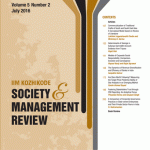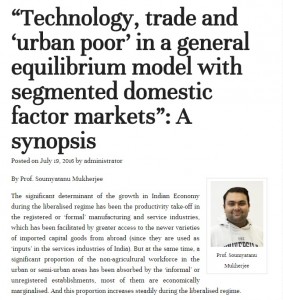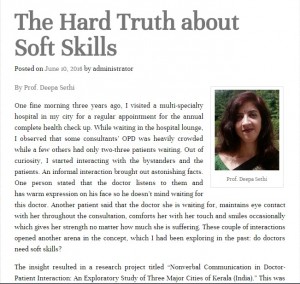Seminar On Pay-per-unit vs. Subscription Pricing for Experiential Products under Competition.
By: Dr. Varun Gupta, Assistant Professor, Supply Chain and Operations Management, Sam and Irene Black School of Business, Penn State Erie, USA.
Abstract of the talk:
In a market where distributors compete to sell experiential products (e.g.; movies and music), should they use pay-per-unit pricing or use subscription pricing? How do consumers’ valuation for the product, and the contract between the distributor and the content provider affect the choice of pricing modality? A distributor using subscription pricing has limited flexibility to exploit consumers with heterogeneous usage. The disadvantage of subscription pricing increases in the presence of a distributor who uses pay-per-unit pricing modality and takes advantage of heterogeneity in consumers’ usage. However, they showed that subscription pricing always yields higher profits for a distributor as well as a vertically integrated firm compared to pay-per-unit pricing. They characterized conditions that lead to a stable market equilibrium in prices as well as price wars. They showed that a powerful content provider finds it optimal to exclusively work with a distributor who uses subscription pricing and drives the pay-per-unit distributor out of the market. Firms profitably co-exist when there is sharing of contractual power among content provider and the distributors. In a conventional supply chain setting, it is optimal for a distributor to procure the product at a zero wholesale price from the manufacturer. In sharp contrast, in supply chains for experiential products, we find that in equilibrium the pay-per-unit distributor does not set wholesale price to zero, in order to avoid a price war with the subscription distributor. Finally, They showed and discussed why a profit maximizing distributor entering such markets must choose a different pricing modality than the incumbent.
To address the aforementioned issues, first answer the following questions: How do consumers choose between different pricing modalities used to sell identical experiential products? When a monopolist distributor offers experiential products to such consumers, which pricing modality gives her a higher profit? What are the equilibrium prices in the market when the pay-per-unit pricing distributor and the subscription pricing distributor compete for consumers? What are the effects on this equilibrium due to the B2B contract with a common content provider? Is there any stable price equilibrium? Finally, what should be the first best pricing choice for a distributor who enters the experiential products market in the presence of an incumbent distributor with a given pricing modality?
They first developed a framework to study consumer characteristics that capture different usage behavior given pay-per-unit and subscription based pricing modalities for experiential products. Then used this framework to analyze the prices, profits, consumer surpluses, and market penetrations of the distributors under various plausible scenarios.
In experiential products industries, such as video streaming industry, they noted that subscription distributors such as Netflix, often have licensing contracts and the pay-per-unit distributors such as iTunes, have a wholesale price contract with the content provider (Movie Studio). The licensing contract is a fee charged by the content provider for providing the product to the distributor. This fee is independent of the distributor’s sales. For example, Netflix pays a fixed fee to license its content from Disney and Starz (see, for example, the Form10-K of Netflix). The wholesale price contract for experiential products is different from those contracts designed for physical product distribution. In particular, the wholesale price is paid after the realization of the consumer demand in case of experiential products. For example, distributors such as iTunes, and Barnes & Noble operate under a wholesale price contract with movie and books providers and pay to the movie studio after sales to customers (see, for example, the Nook website. Nook is the e-book reader sold by Barnes & Noble).
To get a concrete understanding of such industries, model and study the competition between the pay-per-unit pricing distributor and the subscription pricing distributor, who source the products from a common content provider as a multi-stage game. In the first stage, the content provider and the distributors agree to the terms of the wholesale price and licensing fee contracts. This agreement is contingent upon the contractual-power of the players; the strong player dictates (contract-maker) the terms to the weak player (contract-taker). In the second stage, the distributors engage in a Nash game taking the contract terms into account. Finally, demand is realized according to the consumer choice framework we have developed for experiential products.
Some of the findings that they got from their model are as follows. First, they showed that a monopolist selling experiential products benefits using subscription pricing modality over pay-per-unit pricing. They proved this result for a vertically integrated distributor with no marginal cost of production, as well as for a distributor who sources the product from a content provider with a wholesale price contract or a licensing contract.
Second, they showed that when the wholesale price contract is positive there is a unique stable market equilibrium in prices. When the content provider is all powerful, it drives the pay-per-unit distributor out of the market by imposing a high wholesale price and then the subscription distributor charges the monopoly price to consumers.
Third, they showed that in supply chains that distribute experiential products, contractual agreements are set drastically different from conventional supply chains that distribute physical products. For example, in a conventional supply chain, when a distributor sets the wholesale price with a manufacturer, she always sets it to zero (when there is no competition or competing retailers share the same pricing modality). However, due to the difference in pricing modalities, i.e., pay-per-unit vs. subscription, as well as a two-stage setting where distributors set the prices, we observe that the pay-per-unit distributor in our setting does not set the wholesale price at zero. She does so to avoid a price war with the subscription distributor. In addition, they showed that when the contractual-power is shared among the distributors instead of the content provider, the consumers have a higher surplus and the distributors profitably co-exist.
Finally, They endogenized the pricing modality decision of an entrant. They investigated different scenarios such as a weak incumbent with pay-per-unit pricing, and a strong entrant. They showed that it is optimal for an entrant to choose a different pricing modality than the incumbent’s pricing modality to avoid price wars and maximize her profit. They concluded with a discussion of why in certain industries, such as in video streaming industry, observe different pricing modalities. Their model also helped

















 Users Today : 278
Users Today : 278 Users Yesterday : 464
Users Yesterday : 464 This Month : 3486
This Month : 3486 This Year : 122093
This Year : 122093 Total Users : 546081
Total Users : 546081 Who's Online : 1
Who's Online : 1